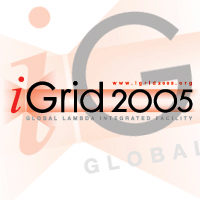iGRID 2005 :: The Global Lambda Integrated Facility (GLIF)
September 26th, 2006 - September 30th, 2006
Categories: Applications, Cultural Heritage, Data Mining, Devices, Education, Multimedia, Networking, Software, Tele-Immersion, Video / Film

About
* All of the information contained below, along with more in-depth information on the event, is also avaliable on the iGrid 2005 website, which can be accessed by clicking the link above.
iGrid 2005, the 4th community-driven biennial International Grid event, is a coordinated effort to accelerate the use of multi-10Gb international and national networks, to advance scientific research, and to educate decision makers, academicians and industry researchers on the benefits of these hybrid networks. This year, iGrid showcases more than four-dozen real-time application demonstrations from 20 countries, as well as a symposium with 25 lectures, panels and master classes on the applications, middleware, and underlying cyberinfrastructure.
The emergence of a global LambdaGrid cyberinfrastructure is leading e-science from a bandwidth-constrained to a bandwidth-rich world. In this new LambdaGrid architecture, it’s possible to access scientific data anywhere in the world over optical networks with almost the same immediacy as if the data were stored on a local hard disk! We see at iGrid a few pioneering researchers who are showing us how this transformed cyberinfrastructure allows them to carry out a new level of science and discovery, using persistent high-performance collaboration on a planetary scale that allows global teams to interactively obtain, analyze, and share vast amounts of distributed data.
Global Lambda Integrated Facility / www.glif.is
GLIF, the Global Lambda Integrated Facility, is an international virtual organization that supports persistent data-intensive scientific research and middleware development on LambdaGrids.
The GLIF community shares a common vision of building a new grid-computing paradigm to support this decade’s most demanding e-science applications. In this paradigm, the central architectural element is optical networks, not computers, which use multiple wavelengths of light (lambdas) on single optical fibers to create supernetworks. The GLIF infrastructure is evolving into a world-scale LambdaGrid laboratory for application and middleware development, where applications rely on dynamically configured networks based on optical wavelengths with known and knowable characteristics, including scheduling, bandwidth and latency guarantees.
Calit2 / www.calit2.net/index.php
Calit2 (California Institute for Telecommunications and Information Technology) on the campus of the University of California, San Diego (UCSD) in La Jolla, California will host iGrid 2005. The iGrid Workshop and subsequent GLIF Meeting will be among the first major events to utilize Calit2’s newly erected facilities through use of its vast resources - advanced networking, visualization and technology environments and cyberinfrastructure.
The numerous press releases, articles and related documentation chronicle applications, technologies, symposia and general iGrid 2005 successes at www.igrid2005.org/media/press.html